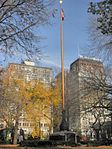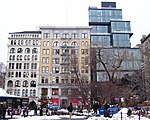USS Recruit (1917)
1917 shipsBuildings and structures in ManhattanClosed installations of the United States NavyInstallations of the United States Navy in New York CityLandlocked ships ... and 3 more
Military recruitmentTraining ships of the United States NavyUnion Square, Manhattan

USS Recruit, also known as the Landship Recruit, was a wooden mockup of a dreadnought battleship constructed by the United States Navy in Manhattan in New York City, as a recruiting tool and training ship during the First World War. Commissioned as if it were a normal vessel of the U.S. Navy and manned by a crew of trainee sailors, Recruit was located in Union Square from 1917 until the end of the war. In 1920, with the reduced requirements for manning in the post-war Navy, Recruit was decommissioned and dismantled, having recruited 25,000 sailors into Navy service.
Excerpt from the Wikipedia article USS Recruit (1917) (License: CC BY-SA 3.0, Authors, Images).USS Recruit (1917)
East 15th Street, New York Manhattan
Geographical coordinates (GPS) Address Nearby Places Show on map
Geographical coordinates (GPS)
| Latitude | Longitude |
|---|---|
| N 40.7356 ° | E -73.9906 ° |
Address
14th Street–Union Square
East 15th Street
10003 New York, Manhattan
New York, United States
Open on Google Maps










